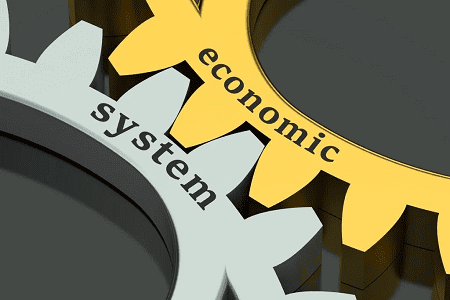Economic systems-
Economic systems are the structures and methods societies use to manage economic activity, including the production, distribution, and consumption of goods and services. Different economic systems vary in how they answer key economic questions: What to produce? How to produce? For whom to produce?
Here are the primary types of economic systems:
1. Traditional Economy
- Characteristics: Decisions are based on customs, traditions, and beliefs. Economic roles and activities are typically passed down through generations.
- Examples: Many indigenous communities and rural areas in developing countries.
- Pros: Stability, predictability, strong social cohesion.
- Cons: Resistance to change, limited economic growth, lower standard of living.
2. Command Economy (Planned Economy)
- Characteristics: The government makes all economic decisions, controls resources, and directs production and distribution.
- Examples: Former Soviet Union, North Korea, Cuba.
- Pros: Can rapidly mobilize resources, ensure equal distribution of goods.
- Cons: Inefficiency, lack of innovation, limited personal freedom, potential for corruption.
3. Market Economy (Capitalism)
- Characteristics: Decisions are made by individuals and businesses based on supply and demand. Prices are determined in free markets.
- Examples: United States, most Western European countries.
- Pros: Efficiency, innovation, variety of goods and services, higher standard of living.
- Cons: Income inequality, market failures, potential for monopolies, exploitation.
4. Mixed Economy
- Characteristics: Combines elements of market and command economies. Both the government and private sector play significant roles.
- Examples: Most modern economies, including those of the United States, Canada, and many European countries.
- Pros: Balances efficiency and equity, mitigates market failures, provides public goods.
- Cons: Complexity, potential for government overreach, requires careful regulation.
Comparison of Economic Systems
| Feature | Traditional Economy | Command Economy | Market Economy | Mixed Economy |
|---|---|---|---|---|
| Decision-Making | Based on customs and traditions | Central government | Individuals and businesses | Both government and market forces |
| Ownership of Resources | Community or family ownership | State ownership | Private ownership | Combination of state and private ownership |
| Incentives | Social approval, tradition | Government directives, quotas | Profit motive | Combination of profit and social welfare |
| Allocation of Resources | Based on tradition | Central planning | Market forces | Market forces with government intervention |
| Advantages | Stability, cultural continuity | Equality, resource mobilization | Efficiency, innovation | Balance of equity and efficiency |
| Disadvantages | Resistance to change, limited growth | Inefficiency, lack of innovation | Inequality, potential for market failures | Complexity, potential regulatory issues |
Key Concepts in Economic Systems
- Supply and Demand: Fundamental concepts in market economies determining the price and quantity of goods.
- Central Planning: A characteristic of command economies where the government plans and controls production.
- Private Property: Essential in market economies, allowing individuals and businesses to own and control resources.
- Public Goods: Goods provided by the government in mixed economies, such as education and infrastructure.
- Market Failure: Situations where markets do not allocate resources efficiently on their own, justifying government intervention.
Understanding these economic systems helps in analyzing how different countries manage their economies and address economic challenges. Each system has its strengths and weaknesses, often leading to a combination of elements to achieve a balance between efficiency, equity, and stability.
What is Required Economic systems
It seems like you’re asking about “planned” economic systems, which are characterized by centralized decision-making and government control over economic activities. In a planned or command economy, such as those historically seen in socialist or communist countries, the government typically determines what goods and services are produced, how they are produced, and for whom they are produced.
Characteristics of Planned (Command) Economic Systems:
- Centralized Decision-Making: The government, rather than markets or individuals, makes key economic decisions. This includes setting production targets, allocating resources, and determining prices.
- State Ownership of Resources: Major industries, infrastructure, and sometimes even land are owned and managed by the state or government agencies.
- Production Targets and Plans: Economic planning involves setting specific targets for production levels of goods and services across various sectors of the economy.
- Price Controls: Prices of goods and services are often set or heavily regulated by the government to control inflation and ensure affordability for citizens.
- Limited Role of Market Forces: Unlike market economies where prices and allocation are primarily determined by supply and demand, planned economies minimize the role of market forces in favor of state directives.
- Income Distribution: The government aims to ensure a more equal distribution of wealth and income among citizens, often through policies such as progressive taxation and welfare programs.
Examples of Planned (Command) Economic Systems:
- Soviet Union: Under Soviet rule, the economy was centrally planned and operated under a command system where the state owned all production and distribution facilities.
- North Korea: This country operates under a highly centralized command economy where the government exercises tight control over economic activities, including production, distribution, and consumption.
- Cuba: Cuba’s economy has been largely state-controlled since the Cuban Revolution, with the government owning and managing most industries and resources.
Advantages and Disadvantages of Planned Economic Systems:
Advantages:
- Social Equity: Planned economies can reduce income inequality and provide essential goods and services to all citizens.
- Centralized Planning: It allows for coordinated efforts to achieve national economic goals, such as infrastructure development and industrial growth.
- Stability: Economic planning can provide stability and predictability in resource allocation and production.
Disadvantages:
- Lack of Incentives: Without market-driven incentives like profit and competition, innovation and efficiency may suffer.
- Bureaucratic Inefficiencies: Centralized decision-making can lead to bureaucratic inefficiencies, delays, and misallocation of resources.
- Limited Consumer Choice: Consumers may have limited choices in goods and services, as the government determines what is produced.
Conclusion:
Planned economic systems represent a stark contrast to market economies, emphasizing central planning and state control over economic activities. While they aim to achieve social equity and stability, they often face challenges such as lack of innovation and inefficiency. The evolution of economic systems globally has shown a trend towards mixed economies, which combine elements of both planned and market systems to balance economic efficiency with social welfare.
Who is Required Economic systems
The phrase “Required Economic systems” doesn’t directly refer to a known economic concept or a specific individual. It’s possible you might be asking about something related to economic systems or a specific economist or theorist.
If you meant to ask about a particular economist or economic concept related to required or necessary economic systems, please provide more context or clarify your question so I can assist you accurately.
When is Required Economic systems
If you’re asking about when a required economic system is used or when it applies, it depends on the context and the specific economic principles being discussed.
If you’re referring to economic systems that are deemed necessary or required for specific conditions or goals, such as economic stability, growth, or social equity, then the answer would depend on the objectives and circumstances of the economy in question. For example:
- During Economic Crises: Required economic systems might refer to interventions like stimulus packages, monetary policy adjustments, or regulatory changes implemented to stabilize an economy during a recession or financial crisis.
- In Developing Countries: Required economic systems could mean policies and structures necessary to promote industrialization, infrastructure development, and poverty reduction.
- For Social Welfare: Required economic systems might involve policies aimed at reducing income inequality, providing essential services like healthcare and education, and ensuring basic needs are met for all citizens.
If your question is related to a specific economic theory or concept known as “Required Economic systems,” please provide additional context or clarify further so I can assist you accurately.
Where is Required Economic systems

It seems there might still be some confusion in your question, as “Required Economic systems” doesn’t correspond to a specific location or geographical entity. Economic systems are frameworks that societies use to organize their economic activities, and they are not tied to a specific physical location.
However, if you’re asking about where different economic systems are implemented or observed, here’s a general overview:
- Traditional Economy: Found in rural and indigenous communities worldwide, especially in less developed regions where economic activities are based on customs, traditions, and barter systems.
- Command Economy: Historically found in countries like the former Soviet Union, China under Mao Zedong, and North Korea, where central authorities control production, distribution, and pricing.
- Market Economy: Predominantly seen in Western countries and many parts of Asia, where production and distribution are largely determined by supply and demand, with minimal government intervention.
- Mixed Economy: Most countries today operate under mixed economies, combining elements of command and market economies. Examples include the United States, Canada, and many European nations.
If you have a specific context or aspect of economic systems you’re interested in, please provide more details so I can assist you further.
How is Required Economic systems
Economic systems refer to the institutional arrangements and mechanisms through which societies organize their production, distribution, and consumption of goods and services. Here’s an explanation of how economic systems generally function:
Key Components and Functions of Economic Systems:
- Resource Allocation: Economic systems determine how scarce resources, such as land, labor, and capital, are allocated among competing uses. This allocation can be based on market forces (demand and supply), central planning by the government, or a combination of both.
- Production Methods: Economic systems dictate how goods and services are produced. This includes decisions on technology adoption, production techniques, and the organization of production processes (e.g., through private enterprises, state-owned enterprises, cooperatives).
- Distribution of Output: Economic systems determine how the output of goods and services is distributed among individuals and groups in society. This includes income distribution, wealth distribution, and access to goods and services.
- Role of Institutions: Institutions such as property rights, legal systems, financial markets, and regulatory frameworks play a crucial role in shaping economic behavior within a particular economic system.
Types of Economic Systems and Their Characteristics:
- Traditional Economy: Based on customs, traditions, and rituals. Economic decisions are often based on social roles and traditions passed down through generations.
- Command Economy: Centralized decision-making by a central authority (typically the government) determines what goods and services are produced, how they are produced, and for whom. Examples include socialist and communist economies.
- Market Economy: Economic decisions are decentralized and made by individuals and firms operating in markets. Prices are determined by supply and demand, and the economy operates with minimal government intervention in terms of production and consumption decisions.
- Mixed Economy: Combines elements of both command and market economies. Governments intervene to regulate markets, provide public goods and services, and mitigate market failures, while allowing market forces to determine most economic decisions.
How Economic Systems Operate:
- Decision-Making Mechanisms: In market economies, decisions are made by individuals and businesses seeking to maximize their own utility or profit. In command economies, decisions are made by government planners or central authorities based on broader social and economic goals.
- Incentive Structures: Economic systems create different incentive structures that influence economic behavior. Market economies provide incentives for innovation, entrepreneurship, and efficiency through profit motives and competition. Command economies may provide incentives through state directives, social rewards, or ideological motivations.
- Impact on Economic Performance: Economic systems affect economic performance in terms of growth, efficiency, income distribution, and stability. Market economies tend to emphasize efficiency and innovation but may result in income inequality. Command economies prioritize equity and social welfare but may face challenges such as inefficiency and lack of innovation.
Conclusion:
Understanding how economic systems are structured and operate is crucial for analyzing their impact on societies and economies. Different economic systems reflect varying degrees of state intervention, market mechanisms, and social norms. The choice of economic system influences economic outcomes and shapes the socio-economic landscape of a country or region.
Case Study on Economic systems
United States vs. China
Economic System Overview
United States: Market Economy
- Characteristics: The U.S. economy operates primarily on market principles where decisions on production, investment, and distribution are made by individuals and businesses interacting in markets. Government intervention is minimal compared to other types of economies.
- Key Features: Private ownership of resources, competition, profit motive, consumer sovereignty, and minimal government regulation in most sectors.
China: Socialist Market Economy with Chinese Characteristics
- Characteristics: China combines socialist principles with market mechanisms, emphasizing state-owned enterprises alongside private enterprises. The government plays a significant role in guiding economic development and maintaining social stability.
- Key Features: State ownership of key sectors (e.g., banking, energy), strategic allocation of resources through central planning, gradual integration into global markets while maintaining political control.
Comparison of Economic Systems
1. Resource Allocation:
- United States: Determined primarily by market forces such as supply and demand, prices, and consumer preferences. Private firms and individuals decide how resources are allocated based on profit motives.
- China: While market forces play a role, the Chinese government uses strategic planning and state-owned enterprises to guide resource allocation. The state plays a significant role in directing investment into key sectors (e.g., infrastructure, technology) to achieve long-term economic goals.
2. Role of Government:
- United States: Government intervention is limited compared to China, focusing mainly on regulation, public goods provision (e.g., infrastructure, education), and maintaining market competition.
- China: Government intervention is extensive, with policies aimed at industrial planning, controlling strategic sectors, and promoting economic growth through state-owned enterprises and targeted investments. The government also plays a key role in currency management and international trade policies.
3. Innovation and Entrepreneurship:
- United States: Encourages innovation and entrepreneurship through robust intellectual property protections, venture capital markets, and a competitive business environment that rewards risk-taking and innovation.
- China: While innovation is encouraged, the government’s control over key sectors and intellectual property rights can sometimes hinder the full potential of entrepreneurship. However, initiatives like the Made in China 2025 plan aim to enhance innovation and technological development.
4. Income Distribution:
- United States: Market-driven income distribution results in varying levels of income inequality. Social safety nets (e.g., welfare programs, unemployment benefits) aim to mitigate disparities.
- China: Despite rapid economic growth, income inequality remains a challenge. The government implements policies to address rural-urban income disparities and improve social welfare programs.
Case Study Implications
- Economic Growth: Both countries have achieved significant economic growth, but China’s growth has been more state-guided, emphasizing infrastructure development and industrialization.
- Global Influence: The U.S. remains a global economic leader, influencing global trade and financial markets. China’s economic rise has positioned it as a major player in global trade, investment, and development financing.
- Challenges: Each system faces unique challenges. The U.S. grapples with income inequality and regulatory challenges, while China faces balancing economic growth with environmental sustainability and social stability.
Conclusion
Comparing the economic systems of the United States and China provides insights into how different institutional arrangements impact economic outcomes, innovation, income distribution, and global influence. While the U.S. prioritizes market mechanisms and private enterprise, China combines socialist principles with strategic state intervention to achieve economic development goals while maintaining political control. Understanding these differences helps analyze their respective strengths, weaknesses, and implications for global economic dynamics.
White paper on Economic systems
Writing a white paper on economic systems can be a comprehensive endeavor that aims to analyze, compare, and provide insights into various economic systems, their characteristics, impacts, and potential future trends. Here’s a structured outline for creating a white paper on economic systems:
Title: Understanding Economic Systems: A Comprehensive Analysis
1. Introduction
- Purpose of the White Paper: Explain the objective of the white paper, which is to provide a detailed analysis of different economic systems.
- Importance: Highlight why understanding economic systems is crucial for policymakers, economists, businesses, and the general public.
2. Overview of Economic Systems
- Definition and Purpose: Define what economic systems are and their primary function in organizing societies’ economic activities.
- Historical Context: Briefly discuss the evolution of economic systems from ancient times to modern-day practices.
3. Types of Economic Systems
- Traditional Economy
- Characteristics
- Examples (e.g., indigenous communities)
- Pros and cons
- Command Economy
- Characteristics
- Historical examples (e.g., Soviet Union, North Korea)
- Pros and cons
- Market Economy
- Characteristics
- Examples (e.g., United States, Western Europe)
- Pros and cons
- Mixed Economy
- Characteristics
- Examples (e.g., most modern economies)
- Pros and cons
4. Comparison of Economic Systems
- Resource Allocation
- How resources are allocated in each system
- Efficiency and effectiveness
- Role of Government
- Government intervention and regulation
- Impact on economic outcomes
- Innovation and Entrepreneurship
- Incentives for innovation
- Support for entrepreneurship
- Income Distribution
- How income is distributed
- Equality vs. inequality
5. Case Studies
- Case Study 1: United States vs. China
- Comparison of market economy vs. socialist market economy
- Economic growth, innovation, income distribution
- Case Study 2: Sweden’s Welfare State
- Characteristics of the Nordic model
- Role of government in social welfare and economic stability
6. Emerging Trends and Future Outlook
- Globalization and Economic Systems
- Impact of globalization on economic systems
- Trends towards convergence or divergence
- Technological Disruption
- How technology is shaping economic systems (e.g., digital economy, AI)
- Opportunities and challenges
- Environmental Sustainability
- Integration of environmental concerns into economic systems
- Green economy initiatives
7. Policy Implications
- Policy Recommendations
- Based on analysis and case studies, suggest policy measures for improving economic efficiency, innovation, and social equity.
8. Conclusion
- Summary of Findings
- Key Takeaways
- Future Directions
9. References
- Citations: Include a comprehensive list of sources and references used throughout the white paper.
Writing Tips:
- Clarity and Structure: Ensure the white paper is well-organized with clear headings and subheadings.
- Evidence-Based: Support arguments with data, case studies, and examples.
- Neutral Tone: Maintain an objective tone and avoid bias towards any particular economic system.
- Accessibility: Make the content accessible to both experts and non-experts in economics.
By following this structured outline, you can create a comprehensive white paper that explores economic systems from multiple angles, providing valuable insights into their functioning, impacts, and future prospects.
Industrial Application of Economic systems
The industrial application of economic systems refers to how different economic frameworks are applied within industries to organize production, allocate resources, and manage economic activities. Here’s how various economic systems manifest in industrial applications:
1. Market Economy
In a market economy:
- Production: Industries produce goods and services based on consumer demand and profitability. Companies decide what to produce based on market signals (prices, consumer preferences).
- Resource Allocation: Resources such as labor, capital, and materials are allocated through market mechanisms. Prices reflect scarcity and demand, guiding allocation decisions.
- Competition: Industries operate in competitive markets where firms vie for market share through innovation, efficiency, and customer satisfaction.
- Innovation: Incentives for innovation are strong due to potential profits from new products or processes.
- Regulation: Government regulations aim to ensure fair competition, protect consumers, and manage externalities (e.g., environmental regulations).
Example: The technology sector in the United States operates under a market economy, with companies like Apple and Google innovating based on consumer demand and competitive pressures.
2. Command Economy
In a command economy:
- Central Planning: Government authorities or central planners determine production quotas, resource allocation, and distribution of goods and services.
- State-Owned Enterprises (SOEs): Industries may be owned and operated by the government, which directs their activities to meet national goals.
- Price Controls: Prices of goods and services are often set by the government to control inflation and ensure affordability.
- Employment: Labor allocation may be determined centrally, with employment decisions influenced by government policies rather than market demand.
Example: Historically, industries in the Soviet Union were managed under a command economy, with production quotas and resource allocation decided by central planners.
3. Mixed Economy
In a mixed economy:
- Public and Private Sectors: Industries include both private firms and state-owned enterprises, with varying degrees of government intervention.
- Regulation: Governments regulate industries to achieve social goals (e.g., environmental protection, consumer rights) while allowing market forces to operate.
- Social Welfare: Government policies support industries with public goods and services, infrastructure development, and social safety nets.
Example: Many European countries have mixed economies where industries like healthcare and transportation combine private sector innovation with government oversight and support.
Industrial Applications and Impact:
- Efficiency: Different economic systems impact industrial efficiency differently. Market economies often promote efficiency through competition and innovation, while command economies may struggle with inefficiencies due to central planning.
- Innovation: Market economies incentivize innovation and technological advancement through profit motives and competition. Command economies may innovate in strategic sectors guided by government priorities.
- Income Distribution: Economic systems influence income distribution within industries and across society. Market economies may result in income disparities, while command and mixed economies aim to mitigate inequalities through policies and redistribution.
- Global Competitiveness: Industrial sectors within different economic systems compete globally based on cost efficiency, product quality, and technological innovation.
Conclusion:
Understanding the industrial application of economic systems helps analyze how different frameworks impact industrial development, innovation, efficiency, and social outcomes. Each economic system presents unique challenges and opportunities for industries, influencing their strategies, operations, and contributions to national economies and global markets.





